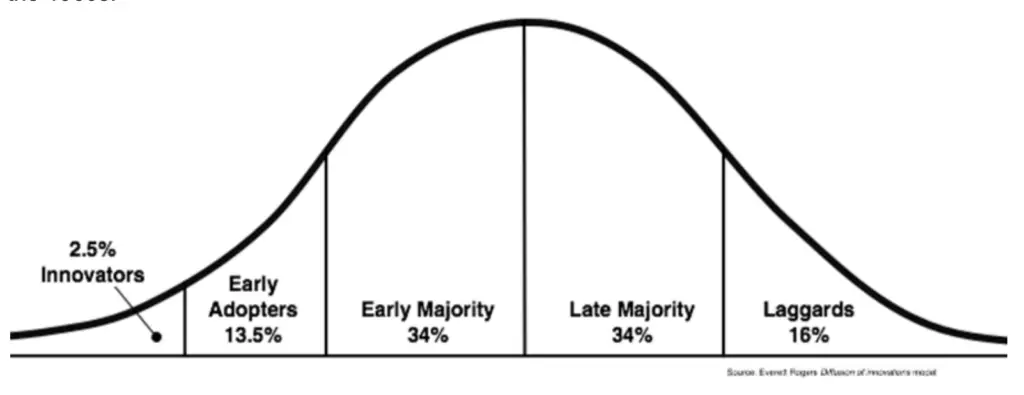Are you looking for the Classworks Special Education program from TouchMath? Click here to go to their site.
Are you looking for the Classworks Special Education program from TouchMath? Click here to go to their site.
You have many hurdles if you’re trying to lead tech adoption in your school or district:
And there is the general issue that comes from introducing anything new. In a teacher’s world, the initial reaction is dread and panic. It’s hard for teachers to take the time from their busy days and routines to learn something new. It means that, for a little while, their routine won’t be as efficient. Also, let’s face it– learning is hard. Our first reaction to doing difficult things is to resist.
But you can use psychology to harness a small minority’s enthusiasm and willingness to learn to get the whole group on board.

Or it’s at least out of date. Researcher Everett Rogers’ developed the Diffusion of Innovation in the 1960s:

The model shows how momentum builds over time to convince the late majority and laggards (totaling 50%) to adopt a new idea. But many organizations feel like the hurdle of convincing 50% is too hard, so they may not even introduce a new initiative completely.
In our schools, the challenge needs to be reframed. It’s not about getting 50% of teachers to use technology in the classroom. Teachers use tech each day in the classroom — teachers are innovative.
It’s about convincing them to use specific technology. How do you get educators to come to a consensus on edtech tools so you get higher tech usage rates?
After studying the dynamics of various groups, psychologist Damon Centola explains that you need to reach 25% adoption within a group for an idea to take off. Here’s how to turn that fact into action inside schools.
Figure out a tech tool that you would like to purchase. One disconnect is that district leaders struggle to pick a tech tool that fits the needs of the majority, so teachers choose separate tools to suit their own needs.
So instead of many teachers using a wide variety of tools in a district, determine the differences between the tools. Talk with teachers to determine why they prefer one tool to another.
Reach out to those that are already using the tech in their classrooms. Learn about how they are using the tool beyond just what the software does.
Show off the work the early adopters are doing in their classroom. Highlight the tool and the person in a way that celebrates them professionally and encourages others to learn more about the strategies and tech tools.
You must get the new edtech tool on your school’s radar before implementing it. You’re building awareness so that the new idea isn’t too shocking or overwhelming later when it becomes the norm to use the new tool.
Teachers want to hear from other teachers because they want to know what really works. They need authentic testimonies and lessons from people they trust before adopting new tech.
Create peer learning opportunities. This is the place where you’re building up to the 25% adoption rate. This early majority group, as Rogers labeled them, will show others that it’s possible and beneficial to adopt the edtech in their classroom.
Many people who introduce new ideas to the school don’t go beyond a few PD sessions. The learning occurs in a vacuum, and not enough people adopt the strategy. You can change that.
If you’re in a leadership role– either an administrator or technology leader– you can define your values and how they play into your vision for your school or district.
When educators see themselves in your big picture, they envision how a new initiative fits into their everyday classroom routine.
One day of training will not change how teachers run their classrooms. It takes time to learn the skill, think through how something new can fit into your busy routine, test a process, and then fully commit.
Ongoing training, informed by the experiences of the teachers who use the tool daily, is key. Once in-depth training occurs, offer continuing support with regular check-ins. The impulse may be to pair early adopters with late adopters and laggards, but resist it. Incentivize early adopters to share what they do e.g. via a screen sharing video while they’re performing a specific task in the app; then give them a gift card to recognize their work!
It’s not a switch that you can flip on inside of school. With the right roll-out program, any new initiative can become the norm.
Schools that have adopted TeacherMade above the 25% level, have done it by taking advantage of our free training webinars and resources, and then harnessing teacher leaders to keep the momentum going..
With TeacherMade, teachers can:
It takes time to get your staff to buy-in and make the commitment to switch up their workflow. With the right tools and a solid adoption plan, you can reach the critical number of 25% adoption. And we are here to help.